Evaluation of Marketing Communication Strategy of Starbucks
VerifiedAdded on 2022/11/15
|12
|3568
|362
AI Summary
This report evaluates the marketing communication strategy of Starbucks, including creative, execution, and media strategies. It also provides recommendations to refine the strategies for future marketing communication programs.
Contribute Materials
Your contribution can guide someone’s learning journey. Share your
documents today.
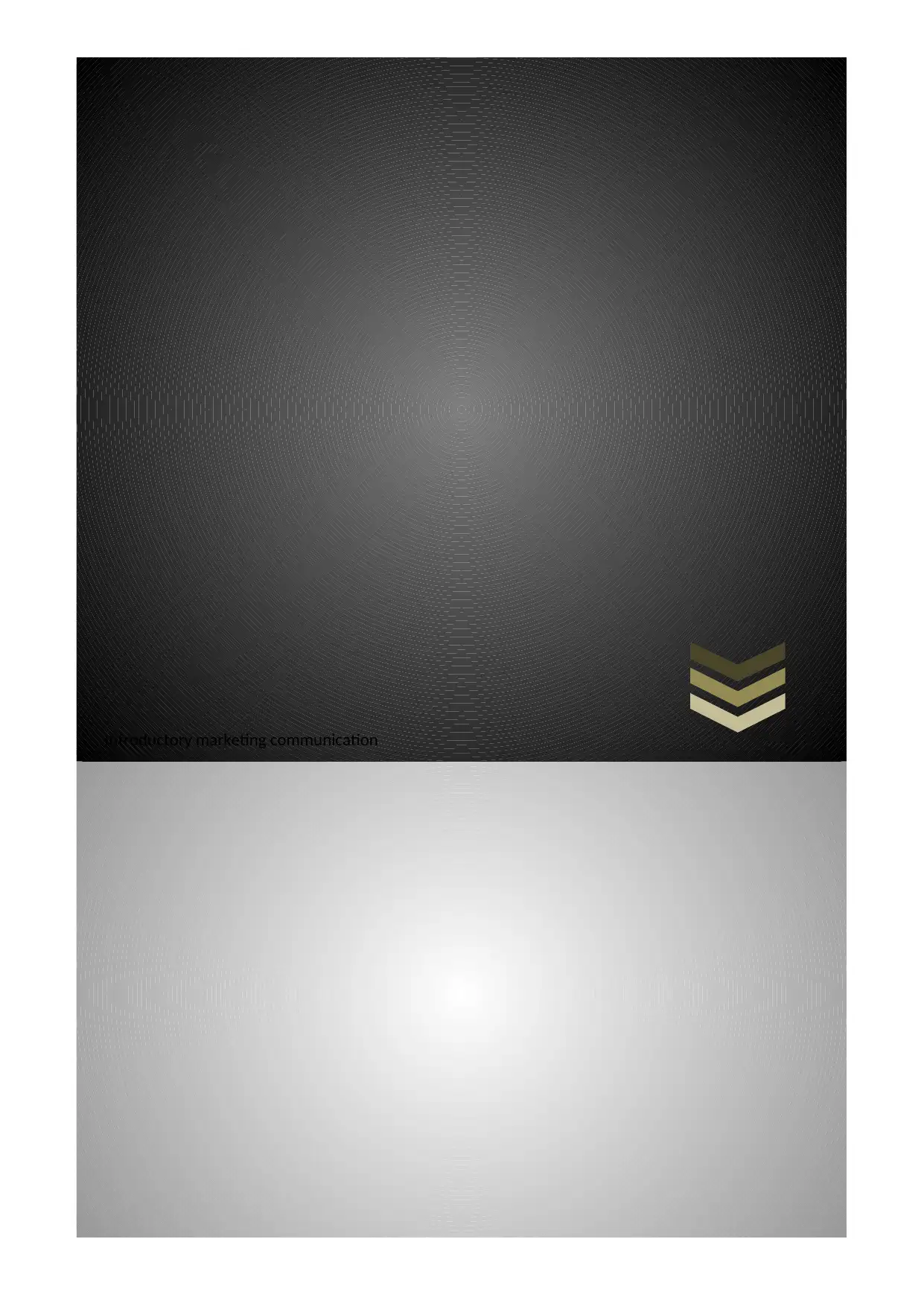
Introductory marketing communication
Secure Best Marks with AI Grader
Need help grading? Try our AI Grader for instant feedback on your assignments.
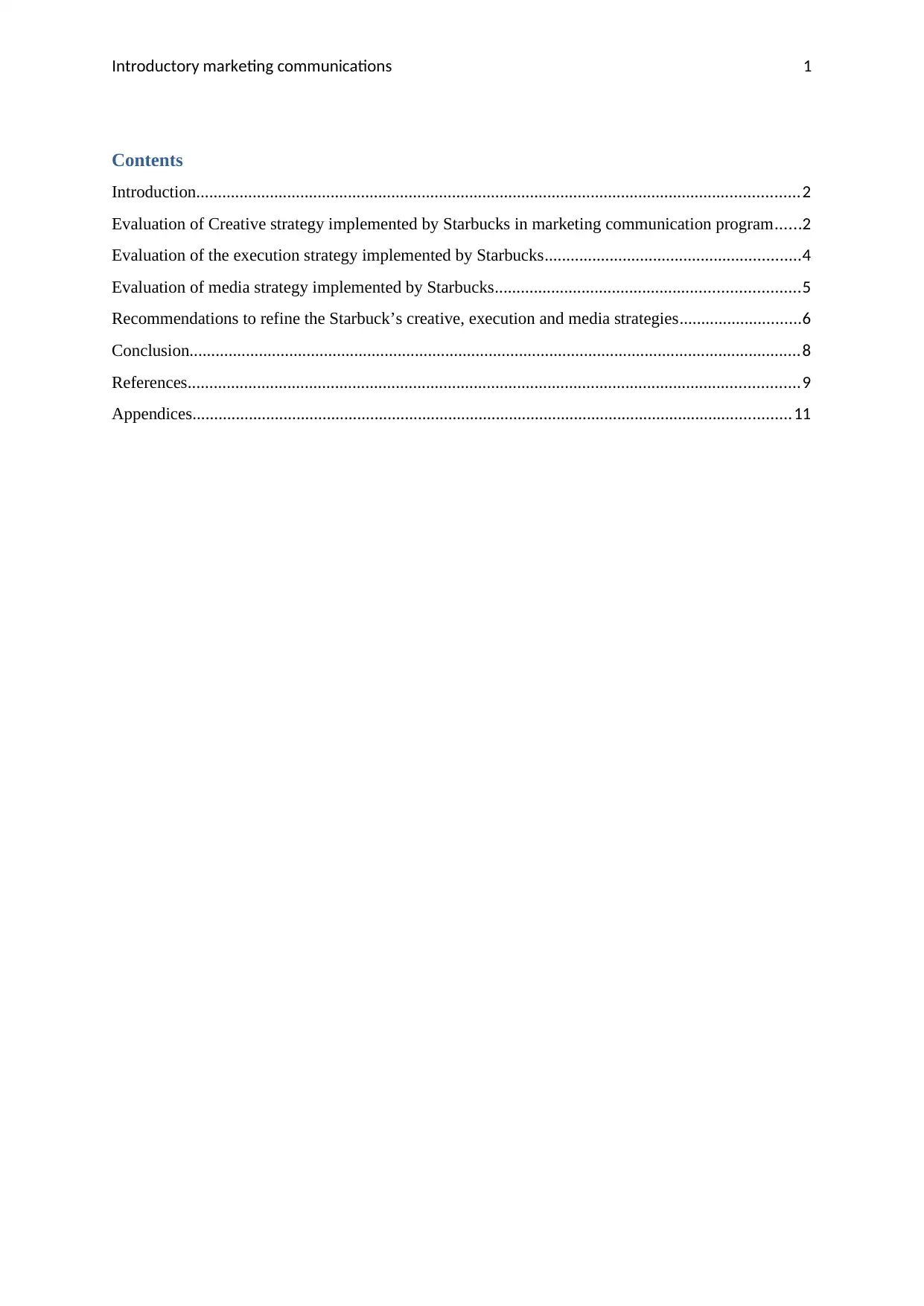
Introductory marketing communications 1
Contents
Introduction...........................................................................................................................................2
Evaluation of Creative strategy implemented by Starbucks in marketing communication program......2
Evaluation of the execution strategy implemented by Starbucks...........................................................4
Evaluation of media strategy implemented by Starbucks......................................................................5
Recommendations to refine the Starbuck’s creative, execution and media strategies............................6
Conclusion.............................................................................................................................................8
References.............................................................................................................................................9
Appendices..........................................................................................................................................11
Contents
Introduction...........................................................................................................................................2
Evaluation of Creative strategy implemented by Starbucks in marketing communication program......2
Evaluation of the execution strategy implemented by Starbucks...........................................................4
Evaluation of media strategy implemented by Starbucks......................................................................5
Recommendations to refine the Starbuck’s creative, execution and media strategies............................6
Conclusion.............................................................................................................................................8
References.............................................................................................................................................9
Appendices..........................................................................................................................................11
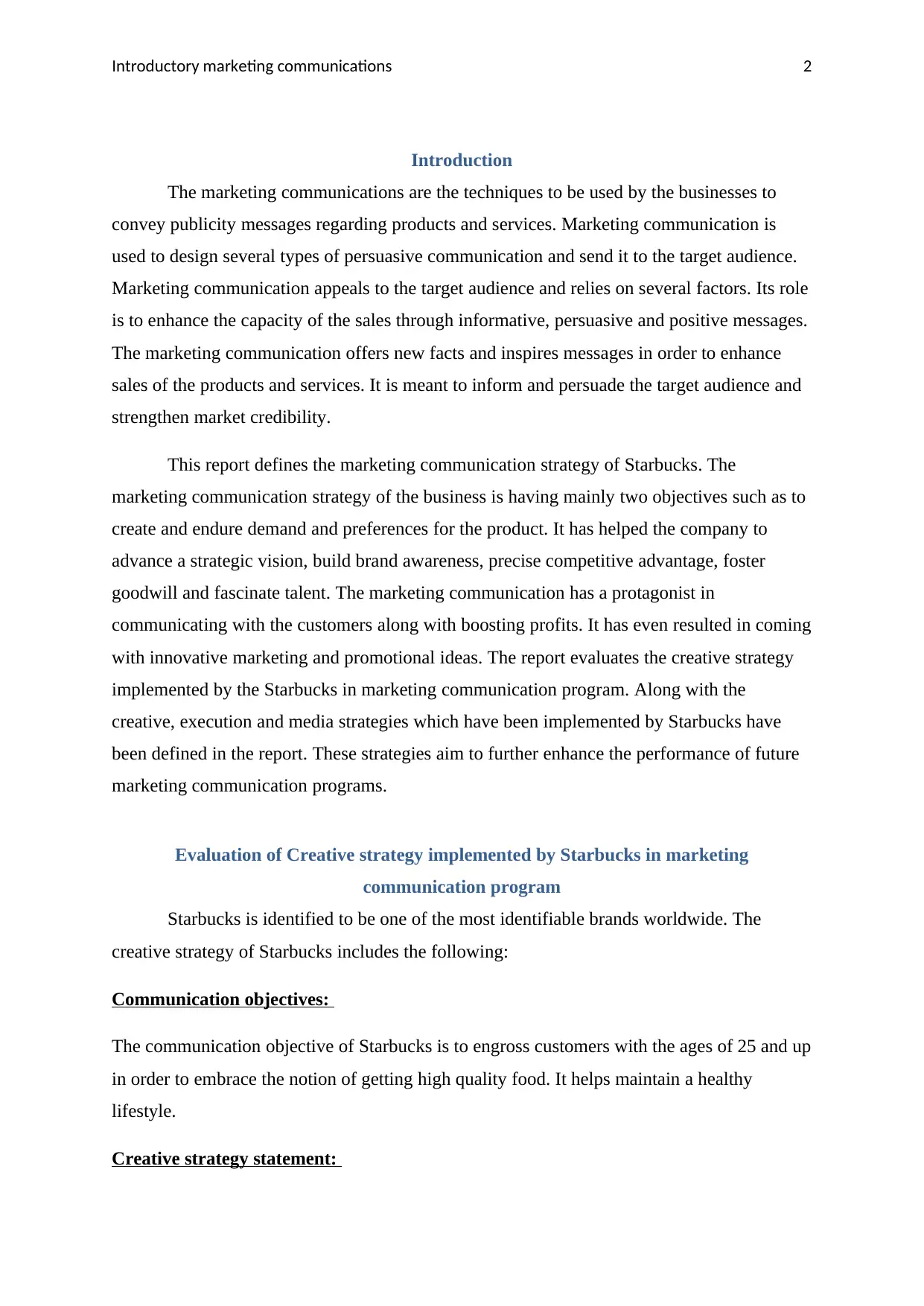
Introductory marketing communications 2
Introduction
The marketing communications are the techniques to be used by the businesses to
convey publicity messages regarding products and services. Marketing communication is
used to design several types of persuasive communication and send it to the target audience.
Marketing communication appeals to the target audience and relies on several factors. Its role
is to enhance the capacity of the sales through informative, persuasive and positive messages.
The marketing communication offers new facts and inspires messages in order to enhance
sales of the products and services. It is meant to inform and persuade the target audience and
strengthen market credibility.
This report defines the marketing communication strategy of Starbucks. The
marketing communication strategy of the business is having mainly two objectives such as to
create and endure demand and preferences for the product. It has helped the company to
advance a strategic vision, build brand awareness, precise competitive advantage, foster
goodwill and fascinate talent. The marketing communication has a protagonist in
communicating with the customers along with boosting profits. It has even resulted in coming
with innovative marketing and promotional ideas. The report evaluates the creative strategy
implemented by the Starbucks in marketing communication program. Along with the
creative, execution and media strategies which have been implemented by Starbucks have
been defined in the report. These strategies aim to further enhance the performance of future
marketing communication programs.
Evaluation of Creative strategy implemented by Starbucks in marketing
communication program
Starbucks is identified to be one of the most identifiable brands worldwide. The
creative strategy of Starbucks includes the following:
Communication objectives:
The communication objective of Starbucks is to engross customers with the ages of 25 and up
in order to embrace the notion of getting high quality food. It helps maintain a healthy
lifestyle.
Creative strategy statement:
Introduction
The marketing communications are the techniques to be used by the businesses to
convey publicity messages regarding products and services. Marketing communication is
used to design several types of persuasive communication and send it to the target audience.
Marketing communication appeals to the target audience and relies on several factors. Its role
is to enhance the capacity of the sales through informative, persuasive and positive messages.
The marketing communication offers new facts and inspires messages in order to enhance
sales of the products and services. It is meant to inform and persuade the target audience and
strengthen market credibility.
This report defines the marketing communication strategy of Starbucks. The
marketing communication strategy of the business is having mainly two objectives such as to
create and endure demand and preferences for the product. It has helped the company to
advance a strategic vision, build brand awareness, precise competitive advantage, foster
goodwill and fascinate talent. The marketing communication has a protagonist in
communicating with the customers along with boosting profits. It has even resulted in coming
with innovative marketing and promotional ideas. The report evaluates the creative strategy
implemented by the Starbucks in marketing communication program. Along with the
creative, execution and media strategies which have been implemented by Starbucks have
been defined in the report. These strategies aim to further enhance the performance of future
marketing communication programs.
Evaluation of Creative strategy implemented by Starbucks in marketing
communication program
Starbucks is identified to be one of the most identifiable brands worldwide. The
creative strategy of Starbucks includes the following:
Communication objectives:
The communication objective of Starbucks is to engross customers with the ages of 25 and up
in order to embrace the notion of getting high quality food. It helps maintain a healthy
lifestyle.
Creative strategy statement:
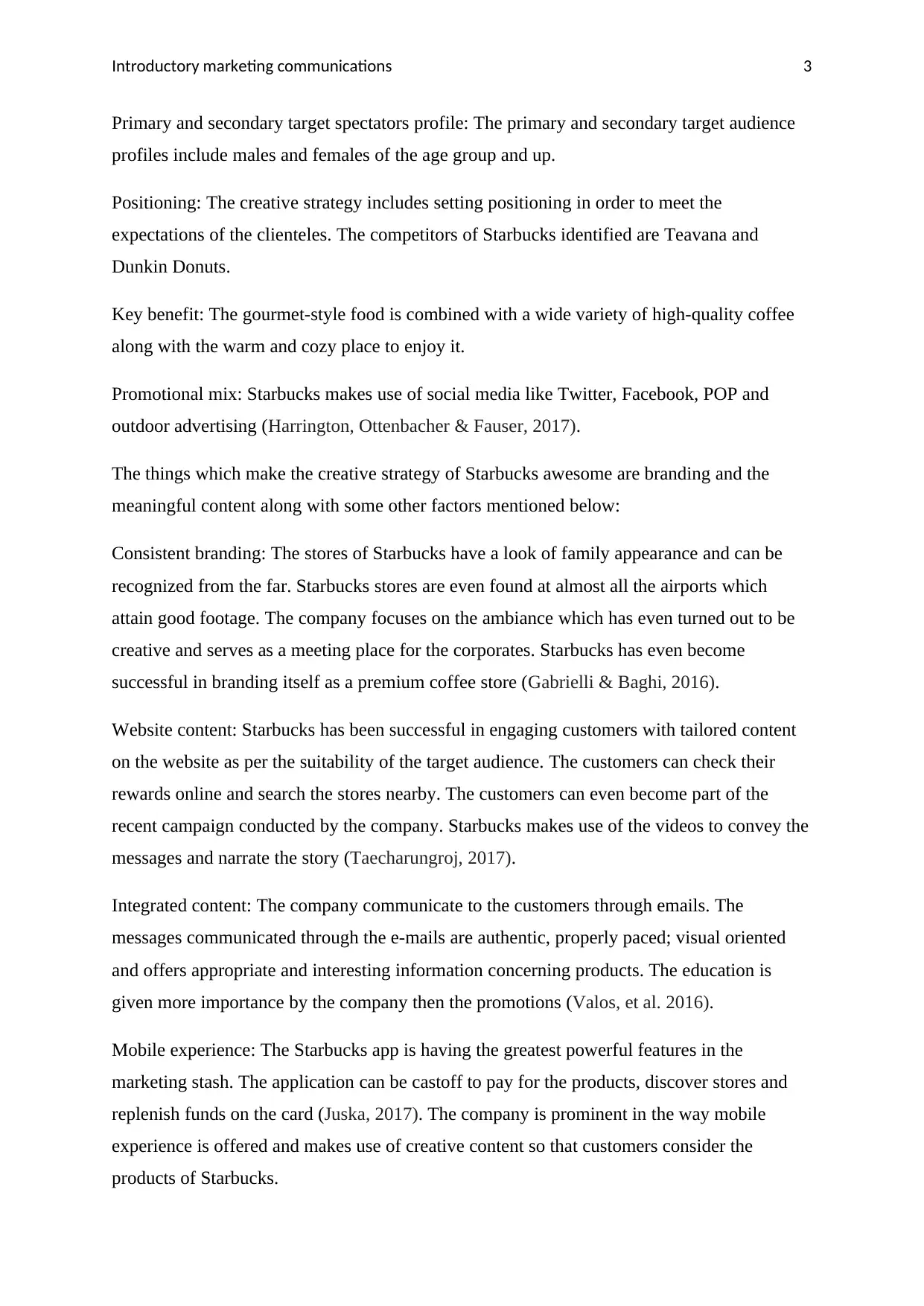
Introductory marketing communications 3
Primary and secondary target spectators profile: The primary and secondary target audience
profiles include males and females of the age group and up.
Positioning: The creative strategy includes setting positioning in order to meet the
expectations of the clienteles. The competitors of Starbucks identified are Teavana and
Dunkin Donuts.
Key benefit: The gourmet-style food is combined with a wide variety of high-quality coffee
along with the warm and cozy place to enjoy it.
Promotional mix: Starbucks makes use of social media like Twitter, Facebook, POP and
outdoor advertising (Harrington, Ottenbacher & Fauser, 2017).
The things which make the creative strategy of Starbucks awesome are branding and the
meaningful content along with some other factors mentioned below:
Consistent branding: The stores of Starbucks have a look of family appearance and can be
recognized from the far. Starbucks stores are even found at almost all the airports which
attain good footage. The company focuses on the ambiance which has even turned out to be
creative and serves as a meeting place for the corporates. Starbucks has even become
successful in branding itself as a premium coffee store (Gabrielli & Baghi, 2016).
Website content: Starbucks has been successful in engaging customers with tailored content
on the website as per the suitability of the target audience. The customers can check their
rewards online and search the stores nearby. The customers can even become part of the
recent campaign conducted by the company. Starbucks makes use of the videos to convey the
messages and narrate the story (Taecharungroj, 2017).
Integrated content: The company communicate to the customers through emails. The
messages communicated through the e-mails are authentic, properly paced; visual oriented
and offers appropriate and interesting information concerning products. The education is
given more importance by the company then the promotions (Valos, et al. 2016).
Mobile experience: The Starbucks app is having the greatest powerful features in the
marketing stash. The application can be castoff to pay for the products, discover stores and
replenish funds on the card (Juska, 2017). The company is prominent in the way mobile
experience is offered and makes use of creative content so that customers consider the
products of Starbucks.
Primary and secondary target spectators profile: The primary and secondary target audience
profiles include males and females of the age group and up.
Positioning: The creative strategy includes setting positioning in order to meet the
expectations of the clienteles. The competitors of Starbucks identified are Teavana and
Dunkin Donuts.
Key benefit: The gourmet-style food is combined with a wide variety of high-quality coffee
along with the warm and cozy place to enjoy it.
Promotional mix: Starbucks makes use of social media like Twitter, Facebook, POP and
outdoor advertising (Harrington, Ottenbacher & Fauser, 2017).
The things which make the creative strategy of Starbucks awesome are branding and the
meaningful content along with some other factors mentioned below:
Consistent branding: The stores of Starbucks have a look of family appearance and can be
recognized from the far. Starbucks stores are even found at almost all the airports which
attain good footage. The company focuses on the ambiance which has even turned out to be
creative and serves as a meeting place for the corporates. Starbucks has even become
successful in branding itself as a premium coffee store (Gabrielli & Baghi, 2016).
Website content: Starbucks has been successful in engaging customers with tailored content
on the website as per the suitability of the target audience. The customers can check their
rewards online and search the stores nearby. The customers can even become part of the
recent campaign conducted by the company. Starbucks makes use of the videos to convey the
messages and narrate the story (Taecharungroj, 2017).
Integrated content: The company communicate to the customers through emails. The
messages communicated through the e-mails are authentic, properly paced; visual oriented
and offers appropriate and interesting information concerning products. The education is
given more importance by the company then the promotions (Valos, et al. 2016).
Mobile experience: The Starbucks app is having the greatest powerful features in the
marketing stash. The application can be castoff to pay for the products, discover stores and
replenish funds on the card (Juska, 2017). The company is prominent in the way mobile
experience is offered and makes use of creative content so that customers consider the
products of Starbucks.
Secure Best Marks with AI Grader
Need help grading? Try our AI Grader for instant feedback on your assignments.
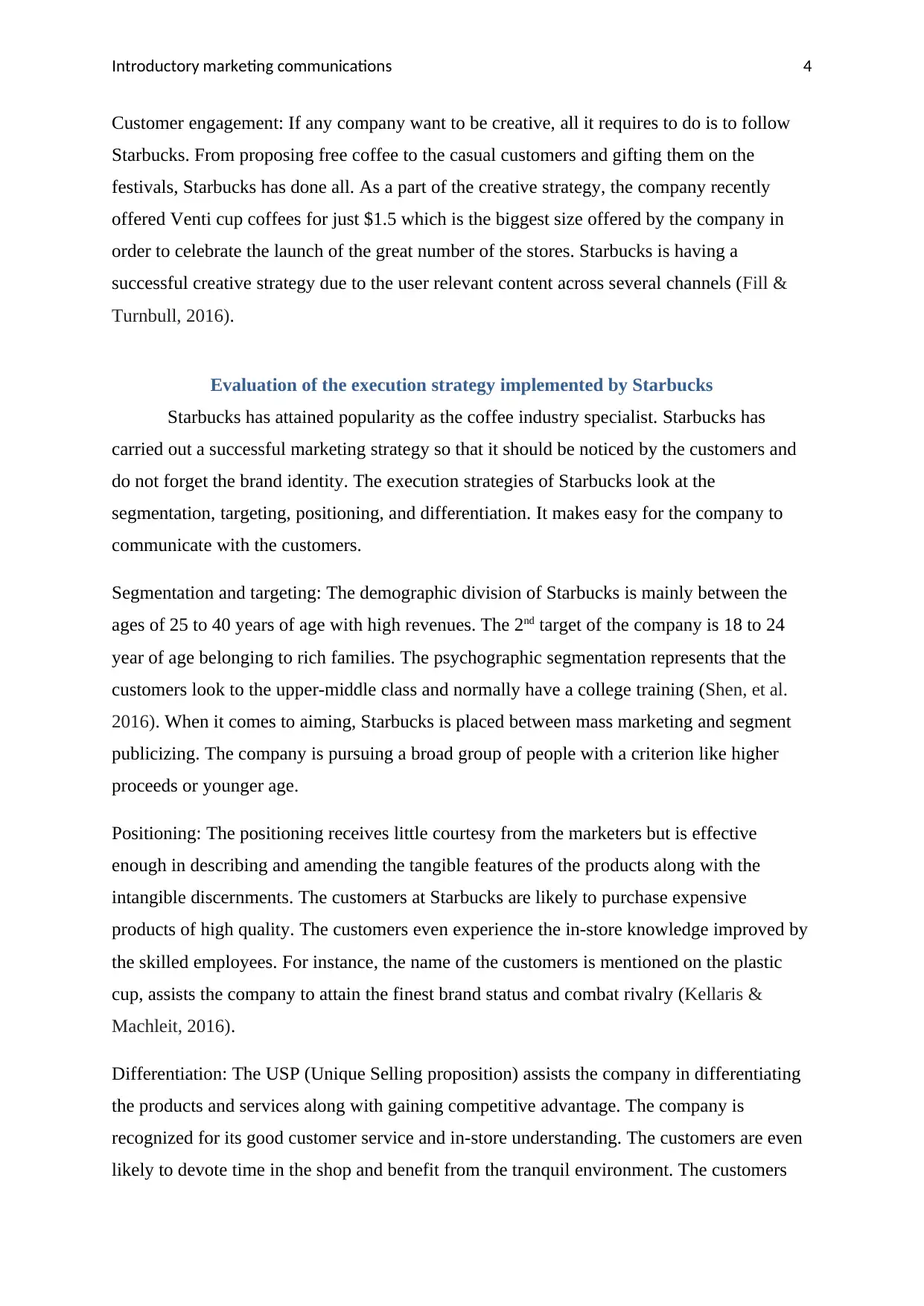
Introductory marketing communications 4
Customer engagement: If any company want to be creative, all it requires to do is to follow
Starbucks. From proposing free coffee to the casual customers and gifting them on the
festivals, Starbucks has done all. As a part of the creative strategy, the company recently
offered Venti cup coffees for just $1.5 which is the biggest size offered by the company in
order to celebrate the launch of the great number of the stores. Starbucks is having a
successful creative strategy due to the user relevant content across several channels (Fill &
Turnbull, 2016).
Evaluation of the execution strategy implemented by Starbucks
Starbucks has attained popularity as the coffee industry specialist. Starbucks has
carried out a successful marketing strategy so that it should be noticed by the customers and
do not forget the brand identity. The execution strategies of Starbucks look at the
segmentation, targeting, positioning, and differentiation. It makes easy for the company to
communicate with the customers.
Segmentation and targeting: The demographic division of Starbucks is mainly between the
ages of 25 to 40 years of age with high revenues. The 2nd target of the company is 18 to 24
year of age belonging to rich families. The psychographic segmentation represents that the
customers look to the upper-middle class and normally have a college training (Shen, et al.
2016). When it comes to aiming, Starbucks is placed between mass marketing and segment
publicizing. The company is pursuing a broad group of people with a criterion like higher
proceeds or younger age.
Positioning: The positioning receives little courtesy from the marketers but is effective
enough in describing and amending the tangible features of the products along with the
intangible discernments. The customers at Starbucks are likely to purchase expensive
products of high quality. The customers even experience the in-store knowledge improved by
the skilled employees. For instance, the name of the customers is mentioned on the plastic
cup, assists the company to attain the finest brand status and combat rivalry (Kellaris &
Machleit, 2016).
Differentiation: The USP (Unique Selling proposition) assists the company in differentiating
the products and services along with gaining competitive advantage. The company is
recognized for its good customer service and in-store understanding. The customers are even
likely to devote time in the shop and benefit from the tranquil environment. The customers
Customer engagement: If any company want to be creative, all it requires to do is to follow
Starbucks. From proposing free coffee to the casual customers and gifting them on the
festivals, Starbucks has done all. As a part of the creative strategy, the company recently
offered Venti cup coffees for just $1.5 which is the biggest size offered by the company in
order to celebrate the launch of the great number of the stores. Starbucks is having a
successful creative strategy due to the user relevant content across several channels (Fill &
Turnbull, 2016).
Evaluation of the execution strategy implemented by Starbucks
Starbucks has attained popularity as the coffee industry specialist. Starbucks has
carried out a successful marketing strategy so that it should be noticed by the customers and
do not forget the brand identity. The execution strategies of Starbucks look at the
segmentation, targeting, positioning, and differentiation. It makes easy for the company to
communicate with the customers.
Segmentation and targeting: The demographic division of Starbucks is mainly between the
ages of 25 to 40 years of age with high revenues. The 2nd target of the company is 18 to 24
year of age belonging to rich families. The psychographic segmentation represents that the
customers look to the upper-middle class and normally have a college training (Shen, et al.
2016). When it comes to aiming, Starbucks is placed between mass marketing and segment
publicizing. The company is pursuing a broad group of people with a criterion like higher
proceeds or younger age.
Positioning: The positioning receives little courtesy from the marketers but is effective
enough in describing and amending the tangible features of the products along with the
intangible discernments. The customers at Starbucks are likely to purchase expensive
products of high quality. The customers even experience the in-store knowledge improved by
the skilled employees. For instance, the name of the customers is mentioned on the plastic
cup, assists the company to attain the finest brand status and combat rivalry (Kellaris &
Machleit, 2016).
Differentiation: The USP (Unique Selling proposition) assists the company in differentiating
the products and services along with gaining competitive advantage. The company is
recognized for its good customer service and in-store understanding. The customers are even
likely to devote time in the shop and benefit from the tranquil environment. The customers
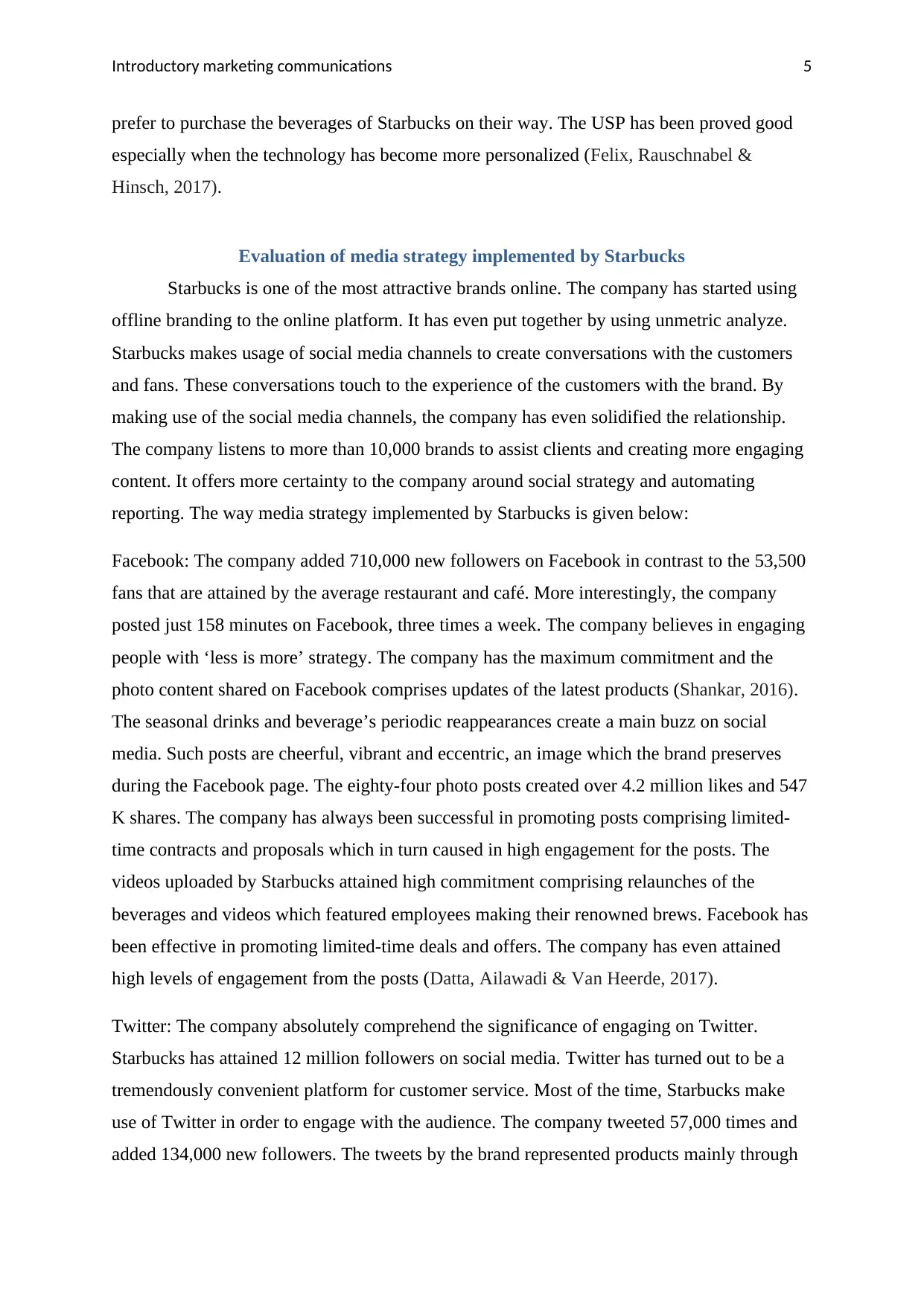
Introductory marketing communications 5
prefer to purchase the beverages of Starbucks on their way. The USP has been proved good
especially when the technology has become more personalized (Felix, Rauschnabel &
Hinsch, 2017).
Evaluation of media strategy implemented by Starbucks
Starbucks is one of the most attractive brands online. The company has started using
offline branding to the online platform. It has even put together by using unmetric analyze.
Starbucks makes usage of social media channels to create conversations with the customers
and fans. These conversations touch to the experience of the customers with the brand. By
making use of the social media channels, the company has even solidified the relationship.
The company listens to more than 10,000 brands to assist clients and creating more engaging
content. It offers more certainty to the company around social strategy and automating
reporting. The way media strategy implemented by Starbucks is given below:
Facebook: The company added 710,000 new followers on Facebook in contrast to the 53,500
fans that are attained by the average restaurant and café. More interestingly, the company
posted just 158 minutes on Facebook, three times a week. The company believes in engaging
people with ‘less is more’ strategy. The company has the maximum commitment and the
photo content shared on Facebook comprises updates of the latest products (Shankar, 2016).
The seasonal drinks and beverage’s periodic reappearances create a main buzz on social
media. Such posts are cheerful, vibrant and eccentric, an image which the brand preserves
during the Facebook page. The eighty-four photo posts created over 4.2 million likes and 547
K shares. The company has always been successful in promoting posts comprising limited-
time contracts and proposals which in turn caused in high engagement for the posts. The
videos uploaded by Starbucks attained high commitment comprising relaunches of the
beverages and videos which featured employees making their renowned brews. Facebook has
been effective in promoting limited-time deals and offers. The company has even attained
high levels of engagement from the posts (Datta, Ailawadi & Van Heerde, 2017).
Twitter: The company absolutely comprehend the significance of engaging on Twitter.
Starbucks has attained 12 million followers on social media. Twitter has turned out to be a
tremendously convenient platform for customer service. Most of the time, Starbucks make
use of Twitter in order to engage with the audience. The company tweeted 57,000 times and
added 134,000 new followers. The tweets by the brand represented products mainly through
prefer to purchase the beverages of Starbucks on their way. The USP has been proved good
especially when the technology has become more personalized (Felix, Rauschnabel &
Hinsch, 2017).
Evaluation of media strategy implemented by Starbucks
Starbucks is one of the most attractive brands online. The company has started using
offline branding to the online platform. It has even put together by using unmetric analyze.
Starbucks makes usage of social media channels to create conversations with the customers
and fans. These conversations touch to the experience of the customers with the brand. By
making use of the social media channels, the company has even solidified the relationship.
The company listens to more than 10,000 brands to assist clients and creating more engaging
content. It offers more certainty to the company around social strategy and automating
reporting. The way media strategy implemented by Starbucks is given below:
Facebook: The company added 710,000 new followers on Facebook in contrast to the 53,500
fans that are attained by the average restaurant and café. More interestingly, the company
posted just 158 minutes on Facebook, three times a week. The company believes in engaging
people with ‘less is more’ strategy. The company has the maximum commitment and the
photo content shared on Facebook comprises updates of the latest products (Shankar, 2016).
The seasonal drinks and beverage’s periodic reappearances create a main buzz on social
media. Such posts are cheerful, vibrant and eccentric, an image which the brand preserves
during the Facebook page. The eighty-four photo posts created over 4.2 million likes and 547
K shares. The company has always been successful in promoting posts comprising limited-
time contracts and proposals which in turn caused in high engagement for the posts. The
videos uploaded by Starbucks attained high commitment comprising relaunches of the
beverages and videos which featured employees making their renowned brews. Facebook has
been effective in promoting limited-time deals and offers. The company has even attained
high levels of engagement from the posts (Datta, Ailawadi & Van Heerde, 2017).
Twitter: The company absolutely comprehend the significance of engaging on Twitter.
Starbucks has attained 12 million followers on social media. Twitter has turned out to be a
tremendously convenient platform for customer service. Most of the time, Starbucks make
use of Twitter in order to engage with the audience. The company tweeted 57,000 times and
added 134,000 new followers. The tweets by the brand represented products mainly through
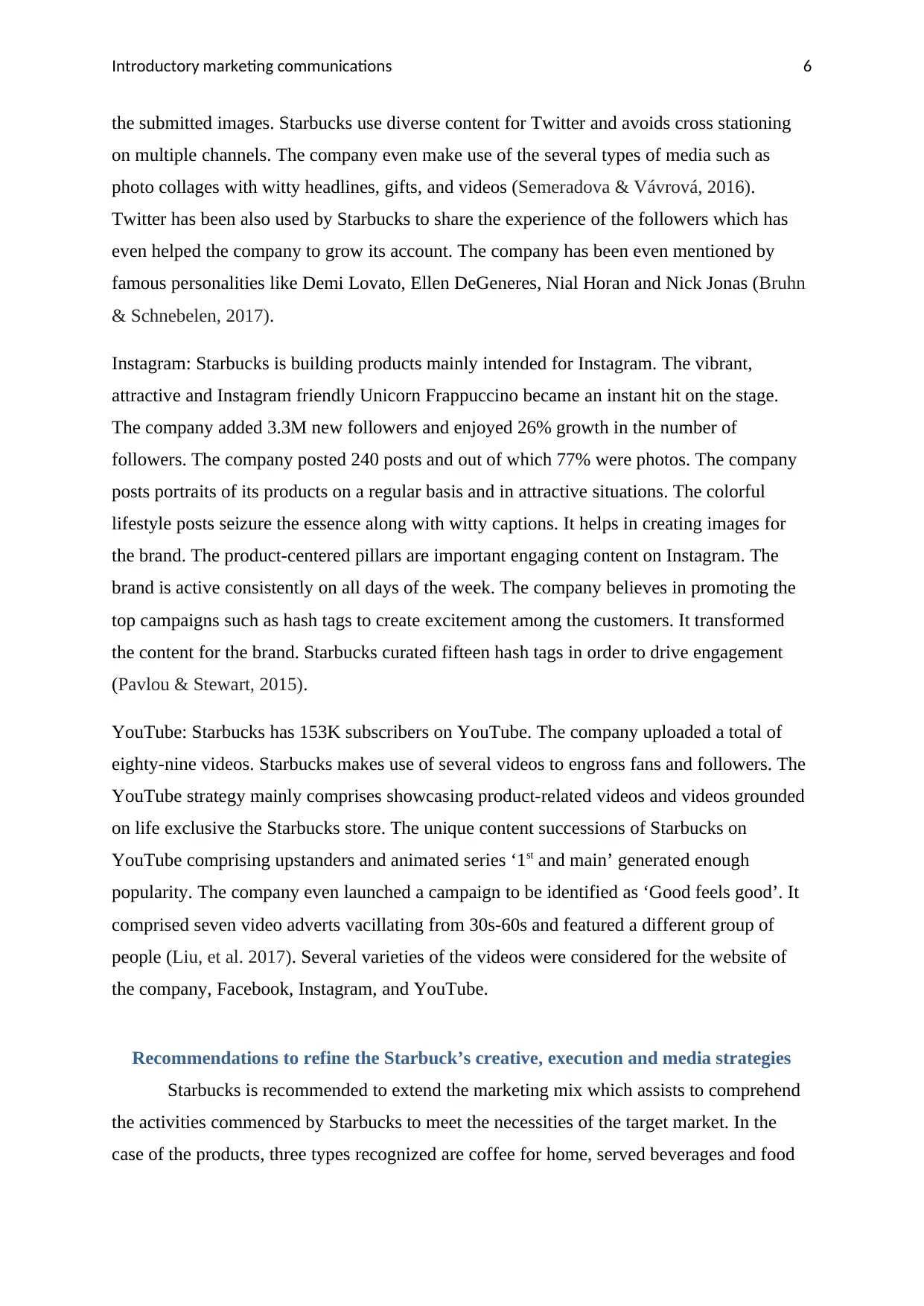
Introductory marketing communications 6
the submitted images. Starbucks use diverse content for Twitter and avoids cross stationing
on multiple channels. The company even make use of the several types of media such as
photo collages with witty headlines, gifts, and videos (Semeradova & Vávrová, 2016).
Twitter has been also used by Starbucks to share the experience of the followers which has
even helped the company to grow its account. The company has been even mentioned by
famous personalities like Demi Lovato, Ellen DeGeneres, Nial Horan and Nick Jonas (Bruhn
& Schnebelen, 2017).
Instagram: Starbucks is building products mainly intended for Instagram. The vibrant,
attractive and Instagram friendly Unicorn Frappuccino became an instant hit on the stage.
The company added 3.3M new followers and enjoyed 26% growth in the number of
followers. The company posted 240 posts and out of which 77% were photos. The company
posts portraits of its products on a regular basis and in attractive situations. The colorful
lifestyle posts seizure the essence along with witty captions. It helps in creating images for
the brand. The product-centered pillars are important engaging content on Instagram. The
brand is active consistently on all days of the week. The company believes in promoting the
top campaigns such as hash tags to create excitement among the customers. It transformed
the content for the brand. Starbucks curated fifteen hash tags in order to drive engagement
(Pavlou & Stewart, 2015).
YouTube: Starbucks has 153K subscribers on YouTube. The company uploaded a total of
eighty-nine videos. Starbucks makes use of several videos to engross fans and followers. The
YouTube strategy mainly comprises showcasing product-related videos and videos grounded
on life exclusive the Starbucks store. The unique content successions of Starbucks on
YouTube comprising upstanders and animated series ‘1st and main’ generated enough
popularity. The company even launched a campaign to be identified as ‘Good feels good’. It
comprised seven video adverts vacillating from 30s-60s and featured a different group of
people (Liu, et al. 2017). Several varieties of the videos were considered for the website of
the company, Facebook, Instagram, and YouTube.
Recommendations to refine the Starbuck’s creative, execution and media strategies
Starbucks is recommended to extend the marketing mix which assists to comprehend
the activities commenced by Starbucks to meet the necessities of the target market. In the
case of the products, three types recognized are coffee for home, served beverages and food
the submitted images. Starbucks use diverse content for Twitter and avoids cross stationing
on multiple channels. The company even make use of the several types of media such as
photo collages with witty headlines, gifts, and videos (Semeradova & Vávrová, 2016).
Twitter has been also used by Starbucks to share the experience of the followers which has
even helped the company to grow its account. The company has been even mentioned by
famous personalities like Demi Lovato, Ellen DeGeneres, Nial Horan and Nick Jonas (Bruhn
& Schnebelen, 2017).
Instagram: Starbucks is building products mainly intended for Instagram. The vibrant,
attractive and Instagram friendly Unicorn Frappuccino became an instant hit on the stage.
The company added 3.3M new followers and enjoyed 26% growth in the number of
followers. The company posted 240 posts and out of which 77% were photos. The company
posts portraits of its products on a regular basis and in attractive situations. The colorful
lifestyle posts seizure the essence along with witty captions. It helps in creating images for
the brand. The product-centered pillars are important engaging content on Instagram. The
brand is active consistently on all days of the week. The company believes in promoting the
top campaigns such as hash tags to create excitement among the customers. It transformed
the content for the brand. Starbucks curated fifteen hash tags in order to drive engagement
(Pavlou & Stewart, 2015).
YouTube: Starbucks has 153K subscribers on YouTube. The company uploaded a total of
eighty-nine videos. Starbucks makes use of several videos to engross fans and followers. The
YouTube strategy mainly comprises showcasing product-related videos and videos grounded
on life exclusive the Starbucks store. The unique content successions of Starbucks on
YouTube comprising upstanders and animated series ‘1st and main’ generated enough
popularity. The company even launched a campaign to be identified as ‘Good feels good’. It
comprised seven video adverts vacillating from 30s-60s and featured a different group of
people (Liu, et al. 2017). Several varieties of the videos were considered for the website of
the company, Facebook, Instagram, and YouTube.
Recommendations to refine the Starbuck’s creative, execution and media strategies
Starbucks is recommended to extend the marketing mix which assists to comprehend
the activities commenced by Starbucks to meet the necessities of the target market. In the
case of the products, three types recognized are coffee for home, served beverages and food
Paraphrase This Document
Need a fresh take? Get an instant paraphrase of this document with our AI Paraphraser
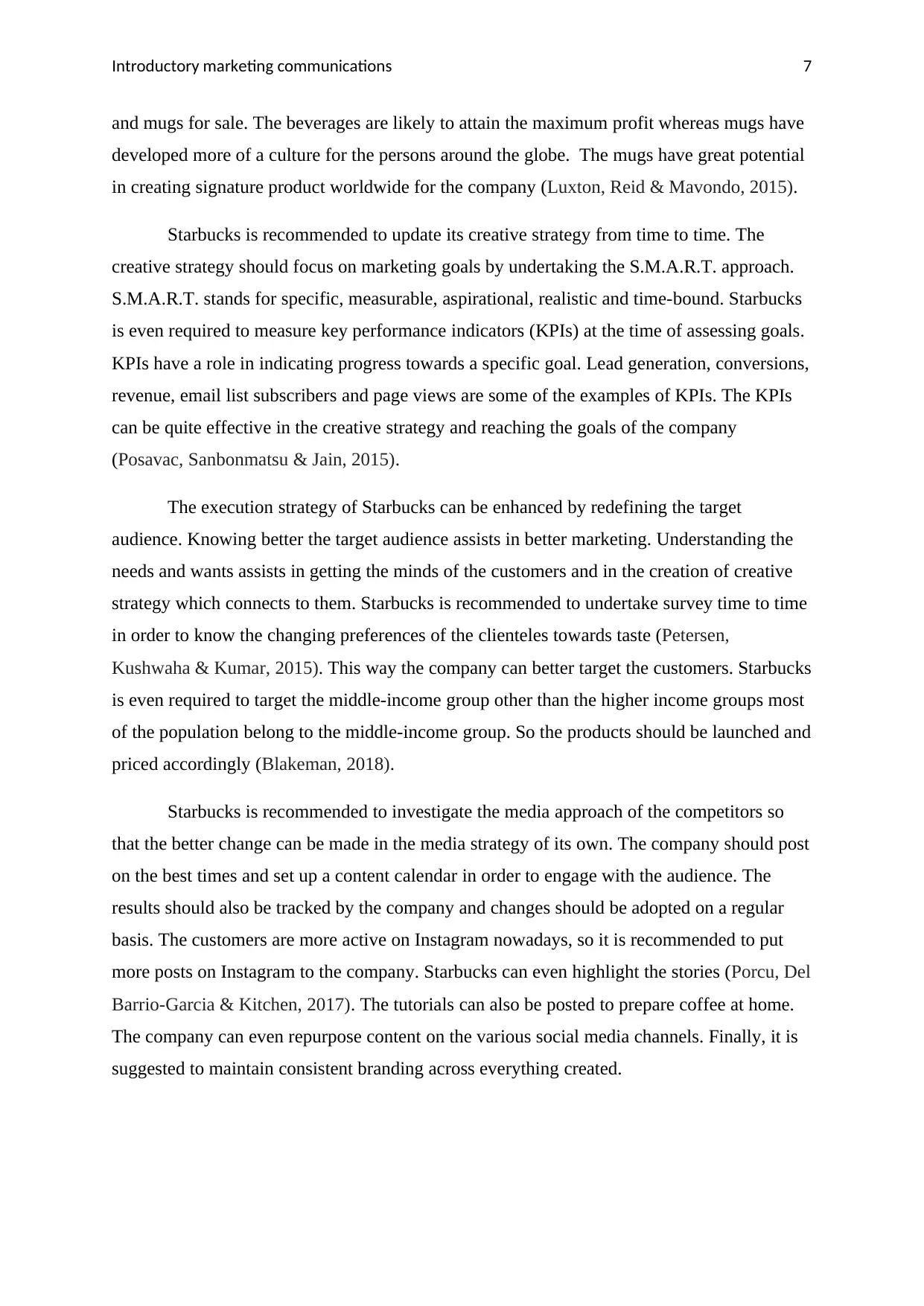
Introductory marketing communications 7
and mugs for sale. The beverages are likely to attain the maximum profit whereas mugs have
developed more of a culture for the persons around the globe. The mugs have great potential
in creating signature product worldwide for the company (Luxton, Reid & Mavondo, 2015).
Starbucks is recommended to update its creative strategy from time to time. The
creative strategy should focus on marketing goals by undertaking the S.M.A.R.T. approach.
S.M.A.R.T. stands for specific, measurable, aspirational, realistic and time-bound. Starbucks
is even required to measure key performance indicators (KPIs) at the time of assessing goals.
KPIs have a role in indicating progress towards a specific goal. Lead generation, conversions,
revenue, email list subscribers and page views are some of the examples of KPIs. The KPIs
can be quite effective in the creative strategy and reaching the goals of the company
(Posavac, Sanbonmatsu & Jain, 2015).
The execution strategy of Starbucks can be enhanced by redefining the target
audience. Knowing better the target audience assists in better marketing. Understanding the
needs and wants assists in getting the minds of the customers and in the creation of creative
strategy which connects to them. Starbucks is recommended to undertake survey time to time
in order to know the changing preferences of the clienteles towards taste (Petersen,
Kushwaha & Kumar, 2015). This way the company can better target the customers. Starbucks
is even required to target the middle-income group other than the higher income groups most
of the population belong to the middle-income group. So the products should be launched and
priced accordingly (Blakeman, 2018).
Starbucks is recommended to investigate the media approach of the competitors so
that the better change can be made in the media strategy of its own. The company should post
on the best times and set up a content calendar in order to engage with the audience. The
results should also be tracked by the company and changes should be adopted on a regular
basis. The customers are more active on Instagram nowadays, so it is recommended to put
more posts on Instagram to the company. Starbucks can even highlight the stories (Porcu, Del
Barrio-Garcia & Kitchen, 2017). The tutorials can also be posted to prepare coffee at home.
The company can even repurpose content on the various social media channels. Finally, it is
suggested to maintain consistent branding across everything created.
and mugs for sale. The beverages are likely to attain the maximum profit whereas mugs have
developed more of a culture for the persons around the globe. The mugs have great potential
in creating signature product worldwide for the company (Luxton, Reid & Mavondo, 2015).
Starbucks is recommended to update its creative strategy from time to time. The
creative strategy should focus on marketing goals by undertaking the S.M.A.R.T. approach.
S.M.A.R.T. stands for specific, measurable, aspirational, realistic and time-bound. Starbucks
is even required to measure key performance indicators (KPIs) at the time of assessing goals.
KPIs have a role in indicating progress towards a specific goal. Lead generation, conversions,
revenue, email list subscribers and page views are some of the examples of KPIs. The KPIs
can be quite effective in the creative strategy and reaching the goals of the company
(Posavac, Sanbonmatsu & Jain, 2015).
The execution strategy of Starbucks can be enhanced by redefining the target
audience. Knowing better the target audience assists in better marketing. Understanding the
needs and wants assists in getting the minds of the customers and in the creation of creative
strategy which connects to them. Starbucks is recommended to undertake survey time to time
in order to know the changing preferences of the clienteles towards taste (Petersen,
Kushwaha & Kumar, 2015). This way the company can better target the customers. Starbucks
is even required to target the middle-income group other than the higher income groups most
of the population belong to the middle-income group. So the products should be launched and
priced accordingly (Blakeman, 2018).
Starbucks is recommended to investigate the media approach of the competitors so
that the better change can be made in the media strategy of its own. The company should post
on the best times and set up a content calendar in order to engage with the audience. The
results should also be tracked by the company and changes should be adopted on a regular
basis. The customers are more active on Instagram nowadays, so it is recommended to put
more posts on Instagram to the company. Starbucks can even highlight the stories (Porcu, Del
Barrio-Garcia & Kitchen, 2017). The tutorials can also be posted to prepare coffee at home.
The company can even repurpose content on the various social media channels. Finally, it is
suggested to maintain consistent branding across everything created.
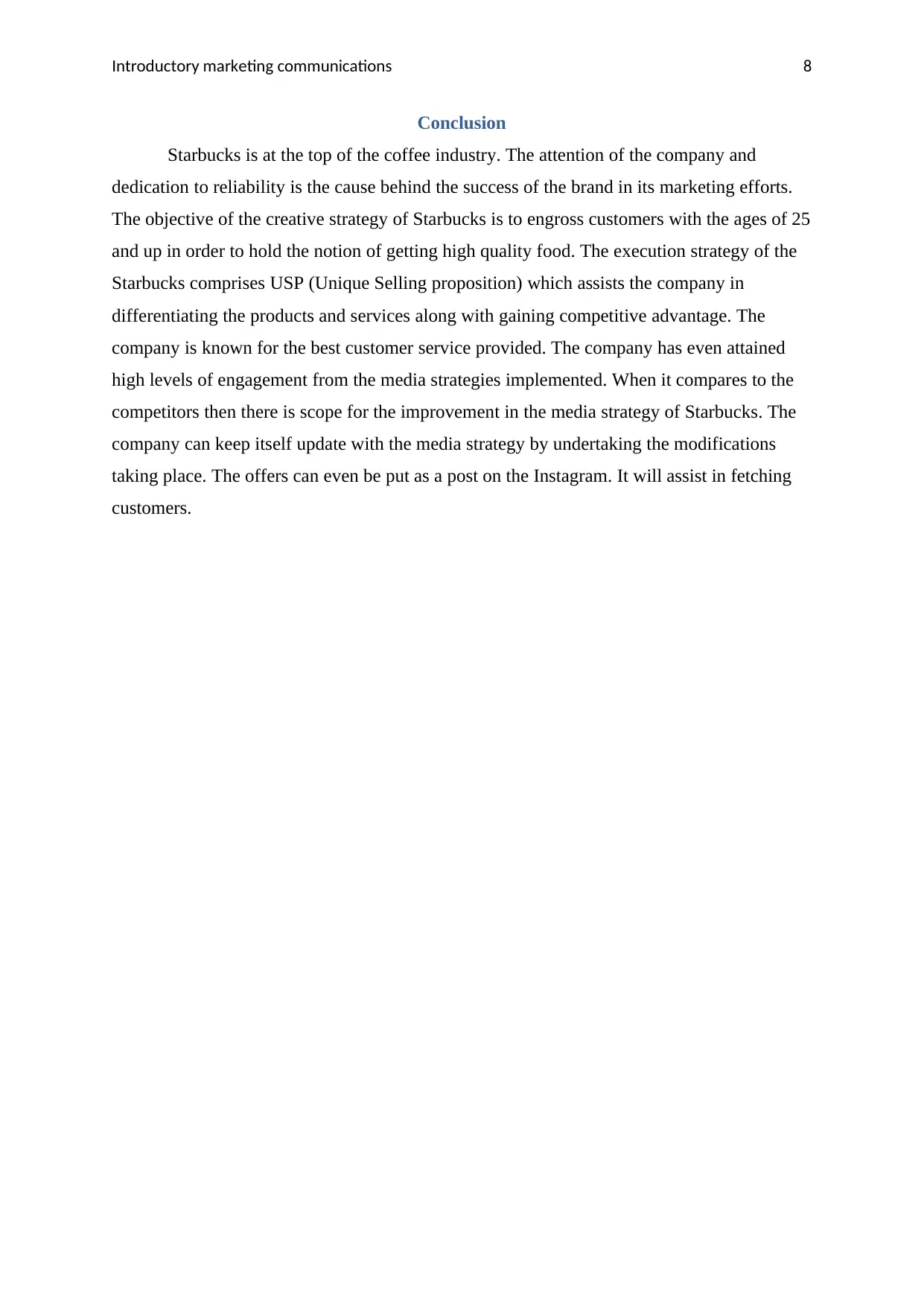
Introductory marketing communications 8
Conclusion
Starbucks is at the top of the coffee industry. The attention of the company and
dedication to reliability is the cause behind the success of the brand in its marketing efforts.
The objective of the creative strategy of Starbucks is to engross customers with the ages of 25
and up in order to hold the notion of getting high quality food. The execution strategy of the
Starbucks comprises USP (Unique Selling proposition) which assists the company in
differentiating the products and services along with gaining competitive advantage. The
company is known for the best customer service provided. The company has even attained
high levels of engagement from the media strategies implemented. When it compares to the
competitors then there is scope for the improvement in the media strategy of Starbucks. The
company can keep itself update with the media strategy by undertaking the modifications
taking place. The offers can even be put as a post on the Instagram. It will assist in fetching
customers.
Conclusion
Starbucks is at the top of the coffee industry. The attention of the company and
dedication to reliability is the cause behind the success of the brand in its marketing efforts.
The objective of the creative strategy of Starbucks is to engross customers with the ages of 25
and up in order to hold the notion of getting high quality food. The execution strategy of the
Starbucks comprises USP (Unique Selling proposition) which assists the company in
differentiating the products and services along with gaining competitive advantage. The
company is known for the best customer service provided. The company has even attained
high levels of engagement from the media strategies implemented. When it compares to the
competitors then there is scope for the improvement in the media strategy of Starbucks. The
company can keep itself update with the media strategy by undertaking the modifications
taking place. The offers can even be put as a post on the Instagram. It will assist in fetching
customers.
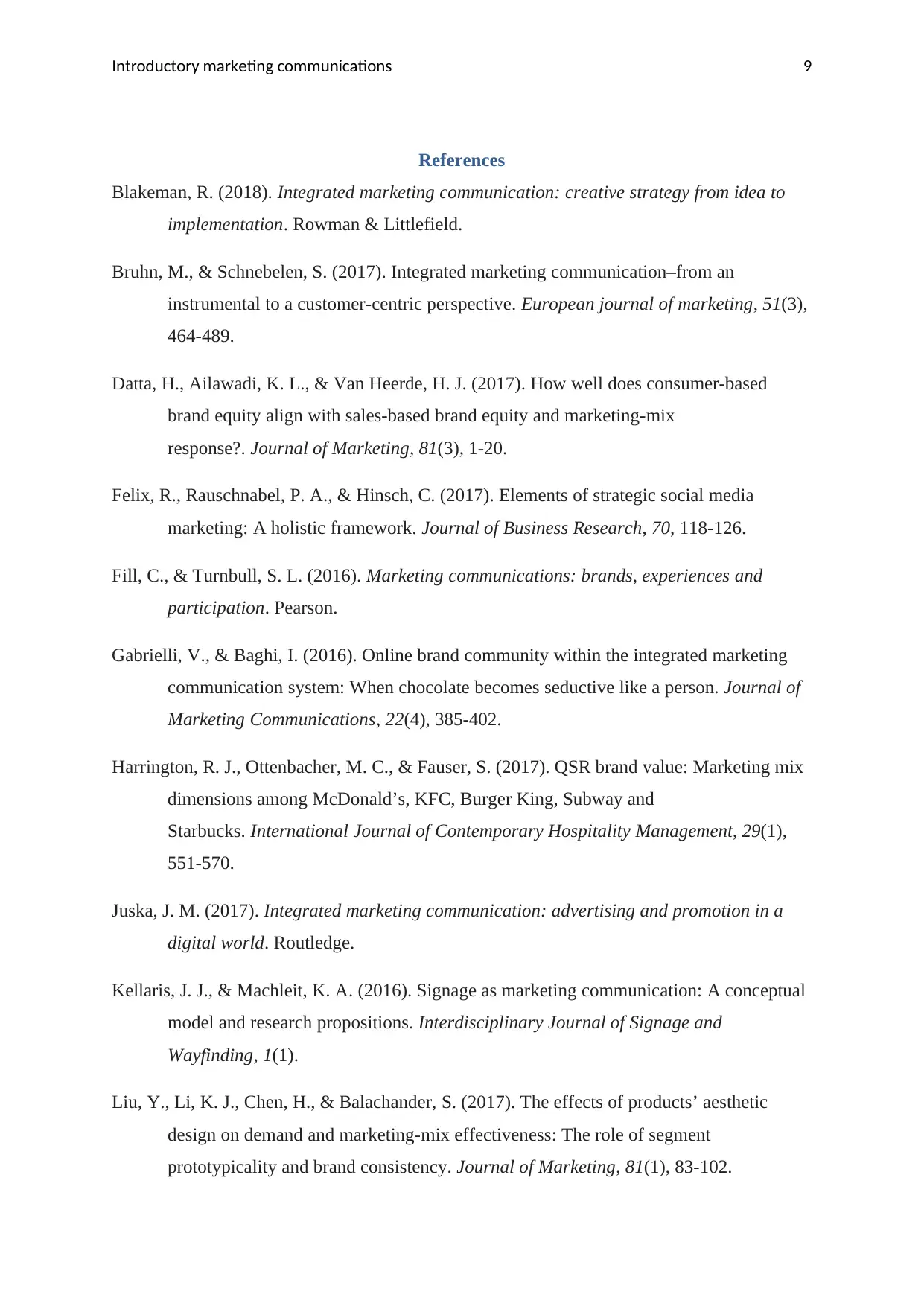
Introductory marketing communications 9
References
Blakeman, R. (2018). Integrated marketing communication: creative strategy from idea to
implementation. Rowman & Littlefield.
Bruhn, M., & Schnebelen, S. (2017). Integrated marketing communication–from an
instrumental to a customer-centric perspective. European journal of marketing, 51(3),
464-489.
Datta, H., Ailawadi, K. L., & Van Heerde, H. J. (2017). How well does consumer-based
brand equity align with sales-based brand equity and marketing-mix
response?. Journal of Marketing, 81(3), 1-20.
Felix, R., Rauschnabel, P. A., & Hinsch, C. (2017). Elements of strategic social media
marketing: A holistic framework. Journal of Business Research, 70, 118-126.
Fill, C., & Turnbull, S. L. (2016). Marketing communications: brands, experiences and
participation. Pearson.
Gabrielli, V., & Baghi, I. (2016). Online brand community within the integrated marketing
communication system: When chocolate becomes seductive like a person. Journal of
Marketing Communications, 22(4), 385-402.
Harrington, R. J., Ottenbacher, M. C., & Fauser, S. (2017). QSR brand value: Marketing mix
dimensions among McDonald’s, KFC, Burger King, Subway and
Starbucks. International Journal of Contemporary Hospitality Management, 29(1),
551-570.
Juska, J. M. (2017). Integrated marketing communication: advertising and promotion in a
digital world. Routledge.
Kellaris, J. J., & Machleit, K. A. (2016). Signage as marketing communication: A conceptual
model and research propositions. Interdisciplinary Journal of Signage and
Wayfinding, 1(1).
Liu, Y., Li, K. J., Chen, H., & Balachander, S. (2017). The effects of products’ aesthetic
design on demand and marketing-mix effectiveness: The role of segment
prototypicality and brand consistency. Journal of Marketing, 81(1), 83-102.
References
Blakeman, R. (2018). Integrated marketing communication: creative strategy from idea to
implementation. Rowman & Littlefield.
Bruhn, M., & Schnebelen, S. (2017). Integrated marketing communication–from an
instrumental to a customer-centric perspective. European journal of marketing, 51(3),
464-489.
Datta, H., Ailawadi, K. L., & Van Heerde, H. J. (2017). How well does consumer-based
brand equity align with sales-based brand equity and marketing-mix
response?. Journal of Marketing, 81(3), 1-20.
Felix, R., Rauschnabel, P. A., & Hinsch, C. (2017). Elements of strategic social media
marketing: A holistic framework. Journal of Business Research, 70, 118-126.
Fill, C., & Turnbull, S. L. (2016). Marketing communications: brands, experiences and
participation. Pearson.
Gabrielli, V., & Baghi, I. (2016). Online brand community within the integrated marketing
communication system: When chocolate becomes seductive like a person. Journal of
Marketing Communications, 22(4), 385-402.
Harrington, R. J., Ottenbacher, M. C., & Fauser, S. (2017). QSR brand value: Marketing mix
dimensions among McDonald’s, KFC, Burger King, Subway and
Starbucks. International Journal of Contemporary Hospitality Management, 29(1),
551-570.
Juska, J. M. (2017). Integrated marketing communication: advertising and promotion in a
digital world. Routledge.
Kellaris, J. J., & Machleit, K. A. (2016). Signage as marketing communication: A conceptual
model and research propositions. Interdisciplinary Journal of Signage and
Wayfinding, 1(1).
Liu, Y., Li, K. J., Chen, H., & Balachander, S. (2017). The effects of products’ aesthetic
design on demand and marketing-mix effectiveness: The role of segment
prototypicality and brand consistency. Journal of Marketing, 81(1), 83-102.
Secure Best Marks with AI Grader
Need help grading? Try our AI Grader for instant feedback on your assignments.

Introductory marketing communications 10
Luxton, S., Reid, M., & Mavondo, F. (2015). Integrated marketing communication capability
and brand performance. Journal of Advertising, 44(1), 37-46.
Pavlou, P. A., & Stewart, D. W. (2015). Interactive advertising: A new conceptual framework
towards integrating elements of the marketing mix. In New Meanings for Marketing
in a New Millennium (pp. 218-222). Springer, Cham.
Petersen, J. A., Kushwaha, T., & Kumar, V. (2015). Marketing communication strategies and
consumer financial decision making: The role of national culture. Journal of
Marketing, 79(1), 44-63.
Porcu, L., Del Barrio-Garcia, S., & Kitchen, P. J. (2017). Measuring integrated marketing
communication by taking a broad organisational approach: The firm-wide IMC
scale. European Journal of Marketing, 51(3), 692-718.
Posavac, S. S., Sanbonmatsu, D. M., & Jain, S. P. (2015). Consumer tunnel vision and
implications for managing the marketing mix. In Cracking the code: Leveraging
consumer psychology to drive profitability (pp. 57-77). Routledge.
Semeradova, T., & Vávrová, J. N. (2016). Using a systemic approach to assess Internet
marketing communication within hospitality industry. Tourism Management
Perspectives, 20, 276-289.
Shankar, V. (2016). Mobile marketing: The way forward. Journal of Interactive
Marketing, 34(1-2).
Shen, G. C. C., Chiou, J. S., Hsiao, C. H., Wang, C. H., & Li, H. N. (2016). Effective
marketing communication via social networking site: The moderating role of the
social tie. Journal of Business Research, 69(6), 2265-2270.
Taecharungroj, V. (2017). Starbucks’ marketing communications strategy on
Twitter. Journal of Marketing Communications, 23(6), 552-571.
Valos, M. J., Haji Habibi, F., Casidy, R., Driesener, C. B., & Maplestone, V. L. (2016).
Exploring the integration of social media within integrated marketing communication
frameworks: Perspectives of services marketers. Marketing Intelligence &
Planning, 34(1), 19-40.
Luxton, S., Reid, M., & Mavondo, F. (2015). Integrated marketing communication capability
and brand performance. Journal of Advertising, 44(1), 37-46.
Pavlou, P. A., & Stewart, D. W. (2015). Interactive advertising: A new conceptual framework
towards integrating elements of the marketing mix. In New Meanings for Marketing
in a New Millennium (pp. 218-222). Springer, Cham.
Petersen, J. A., Kushwaha, T., & Kumar, V. (2015). Marketing communication strategies and
consumer financial decision making: The role of national culture. Journal of
Marketing, 79(1), 44-63.
Porcu, L., Del Barrio-Garcia, S., & Kitchen, P. J. (2017). Measuring integrated marketing
communication by taking a broad organisational approach: The firm-wide IMC
scale. European Journal of Marketing, 51(3), 692-718.
Posavac, S. S., Sanbonmatsu, D. M., & Jain, S. P. (2015). Consumer tunnel vision and
implications for managing the marketing mix. In Cracking the code: Leveraging
consumer psychology to drive profitability (pp. 57-77). Routledge.
Semeradova, T., & Vávrová, J. N. (2016). Using a systemic approach to assess Internet
marketing communication within hospitality industry. Tourism Management
Perspectives, 20, 276-289.
Shankar, V. (2016). Mobile marketing: The way forward. Journal of Interactive
Marketing, 34(1-2).
Shen, G. C. C., Chiou, J. S., Hsiao, C. H., Wang, C. H., & Li, H. N. (2016). Effective
marketing communication via social networking site: The moderating role of the
social tie. Journal of Business Research, 69(6), 2265-2270.
Taecharungroj, V. (2017). Starbucks’ marketing communications strategy on
Twitter. Journal of Marketing Communications, 23(6), 552-571.
Valos, M. J., Haji Habibi, F., Casidy, R., Driesener, C. B., & Maplestone, V. L. (2016).
Exploring the integration of social media within integrated marketing communication
frameworks: Perspectives of services marketers. Marketing Intelligence &
Planning, 34(1), 19-40.
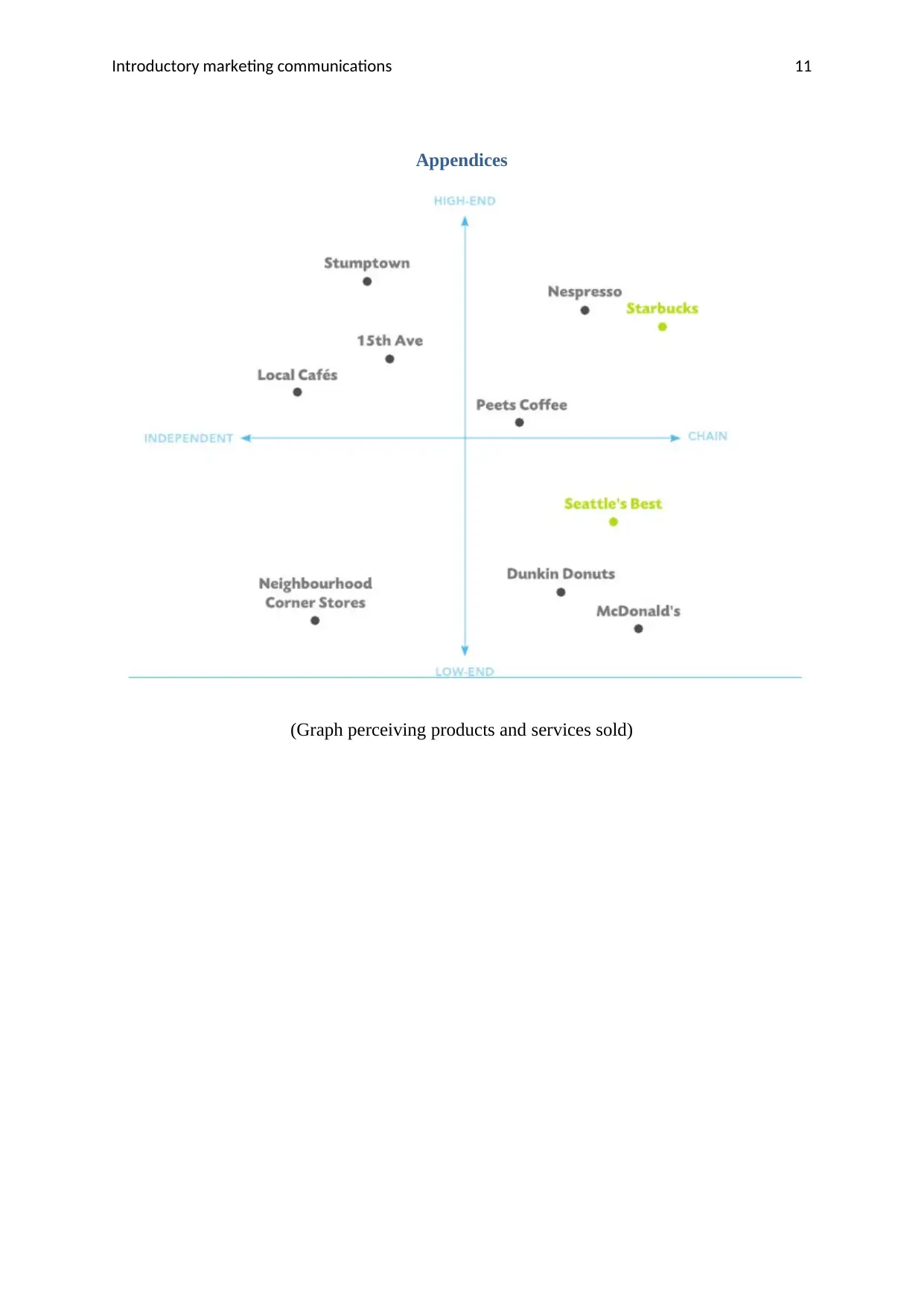
Introductory marketing communications 11
Appendices
(Graph perceiving products and services sold)
Appendices
(Graph perceiving products and services sold)
1 out of 12
Related Documents
Your All-in-One AI-Powered Toolkit for Academic Success.
+13062052269
info@desklib.com
Available 24*7 on WhatsApp / Email
![[object Object]](/_next/static/media/star-bottom.7253800d.svg)
Unlock your academic potential
© 2024 | Zucol Services PVT LTD | All rights reserved.




